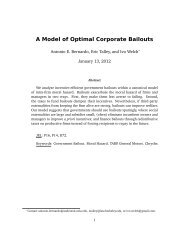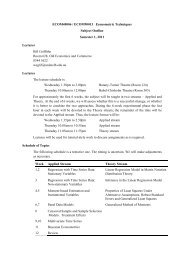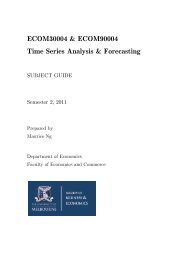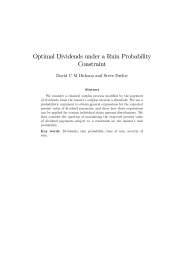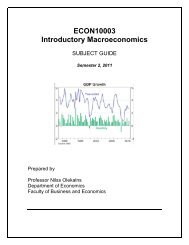Bayesian Inference in the Seemingly Unrelated Regressions Model
Bayesian Inference in the Seemingly Unrelated Regressions Model
Bayesian Inference in the Seemingly Unrelated Regressions Model
Create successful ePaper yourself
Turn your PDF publications into a flip-book with our unique Google optimized e-Paper software.
20<br />
Suppose a set of J l<strong>in</strong>ear restrictions is written as<br />
⎛η⎞<br />
Rβ = ( R1 R2)<br />
⎜ ⎟=<br />
r<br />
⎝γ<br />
⎠<br />
(37)<br />
where R<br />
1<br />
is ( J × J ) and nons<strong>in</strong>gular, R<br />
2<br />
is ( J × ( K − J )) , and η and γ are J and<br />
( K − J ) dimensional sub-vectors of β , respectively. To make this partition, it may be<br />
necessary to reorder <strong>the</strong> elements <strong>in</strong> β . Correspond<strong>in</strong>gly, we can reorder <strong>the</strong> columns<br />
of X and partition it so that <strong>the</strong> l<strong>in</strong>ear SUR model can be written as<br />
⎛η⎞<br />
y = Xβ + e= ( X1 X2)<br />
⎜ ⎟+<br />
e<br />
⎝γ<br />
⎠<br />
(38)<br />
This reorder<strong>in</strong>g may destroy <strong>the</strong> block-diagonal properties of X . From (37), we can<br />
solve for η as<br />
−1<br />
1 2<br />
η= R ( r−R<br />
γ )<br />
(39)<br />
Substitut<strong>in</strong>g (39) <strong>in</strong>to (38) and rearrang<strong>in</strong>g yields<br />
− 1 −1<br />
1 1 2 1 1 2<br />
y− X R r = ( X − X R R ) γ + e<br />
or<br />
z = Zγ + e<br />
(40)<br />
where<br />
−1<br />
z = y − X R r , and<br />
1<br />
1<br />
−1<br />
2 1 1 2<br />
Z = X − X R R represent new sets of “observations”.<br />
In general, Z and γ can no longer be partitioned unambiguously <strong>in</strong>to M separate<br />
equations. However, <strong>the</strong> stochastic properties of e rema<strong>in</strong> <strong>the</strong> same. Thus, all <strong>the</strong><br />
results <strong>in</strong> Sections II and III that did not rely on a partition<strong>in</strong>g of X and β can still be<br />
applied to <strong>the</strong> model <strong>in</strong> (40). In particular, a Gibbs sampler can be used to draw γ and



